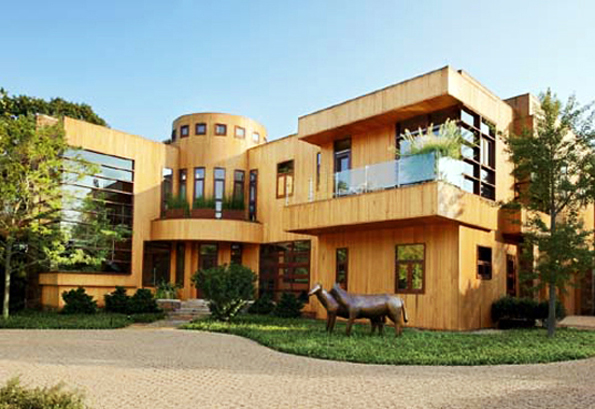 |
| If you can afford to build a LEED-certified home, you can get tax breaks in Niagara County thanks to new county law. |
|
|
|
|
|
Last week Republicans on the Niagara County Legislature passed a new law granting tax breaks for residents and developers who build houses or commercial buildings that qualify for "LEED certification."
LEED stands for Leadership in Energy and Environmental Design and the certificates are awarded by the US Green Building Council, a group of developers, architects and contractors that specializes in designing buildings based on their standards of green.
A growing list of U.S. federal agencies and state and local governments offer rewards for LEED certification.
With the new law, Niagara County has joined the list, and homes or commercial buildings that earn LEED certification after Sept 16, 2014 and pay zero county property taxes for three years and then then get four years of discounted taxes.
The proposed law was sponsored by Legislator Michael A. Hill, R-Hartland, and takes advantage of a 2012 law signed by Gov. Andrew Cuomo which permits municipalities to exempt buildings certified by LEED or other green initiative standards from taxes.
Hill cited Charles Eisenmann of Amherst as the impetus for him to sponsor the new law. Eisenmann purchased land on Tonawanda Creek Road in the Town of Lockport, and wants to build a $350,000 home there, moving from Erie to Niagara County.
Eisenmann said he would build the home to meet LEED standards if he could get tax breaks. Otherwise he would spend less money on the home.
Hill and his GOP cohorts passed the new law arguing that a tax break will encourage other people to come to Niagara County and build LEED-certified properties which are models of green technology.
There is a popular misconception that LEED certification guarantees energy efficiency. LEED-certified homes and commercial buildings do not have to prove energy efficiency after they are built. LEED uses computer software to predict future energy use.
Based on the number of points a building receives, a building is awarded a silver designation for 50 to 59 points, gold for 60 to 79 points and platinum for over 80 points.
Niagara County has opted to go with silver as the threshold for tax breaks.
Since LEED measures total points, designers and builders are free to choose from several categories to achieve LEED?points.
While LEED points are awarded for sustainability, recyclability of building materials used, projected energy savings and the overall footprint of the structure, LEED points are also awarded for comfort, desirability, luxury and other items that benefit owners but do little for the planet.
Items such as carbon-footprint reducing utilities and materials get points, but so do designs using natural light, windows with a view, proposing to keep the building extra clean, using the right colors, textures, ceiling height, window access and shading, surface finishes, and furniture comfort. You even get points for hiring a LEED-certified architect.
The LEED-certification is based on the design, not the actual building.
In reality, LEED may be overrated. Studies suggest that LEED-certified buildings use the same energy and produce equal greenhouse gas emissions as non-LEED-certified buildings.
This is because the LEED?point system is skewed to give designers lots of non-energy saving choices to earn points and make it practical (if not too easy) to win LEED certification.
A USA Today review showed that 7,100 certified commercial building projects targeted easy and inexpensive green points, such as creating healthy spaces and providing educational displays in the building and few LEED certified builders adopted renewable energy, such as solar photovoltaic, because these are too costly to build.
Designers manipulate the point system and use certain designs to compensate for others making energy conservation the weakest part in LEED evaluation.
In 2006, a study showed 21 NYC?LEED-certified office buildings collectively showed no energy savings compared with 21 similar, non-LEED buildings.
A 2009 study analyzed 100 LEED-certified buildings and 100 conventional "twin" buildings. A review of the study concluded that, collectively, the LEED-certified buildings showed no significant energy savings or greenhouse gas emission reductions.
In 2013, a study analyzed LEED-certified buildings in New York City and found that buildings with LEED Silver ratings used more energy than their conventional counterparts.
Even the US Green Building Council admits that "(LEED) buildings have a poor track record for performing as predicted during design."
LEED-certified buildings get higher rents, sale prices and occupancy rates. This is in part because various government agencies incentivize LEED-certified property owners with tax breaks, tax credits, reduced fees, priority permitting, and free technical assistance.
The new homes that will get LEED certification in Niagara County will probably use as much energy as conventional properties, since they tend to be larger and, as studies have shown, use as much energy as conventional properties.
While the 11-member GOP majority supported the new law, the four Democrats in the minority weren't enthusiastic.
Pointing out that people who can afford to build a $350,000 home with LEED certification will use the same county services, Minority Leader Dennis F. Virtuoso, D-Niagara Falls, said, "Any tax reduction means other taxpayers have to make that up. Why should the county subsidize this?"
"This isn't subsidizing. I call this incentivizing," Hill rebutted. "… We're incentivizing people to build these types of buildings."
Virtuoso pointed out that average taxpayers normally wouldn't qualify for tax breaks since LEED homes are typically upscale. LEED charges are from $2,900 to $1 million for certification depending on the size of the building. |

